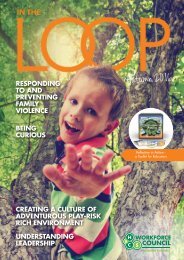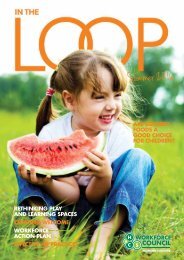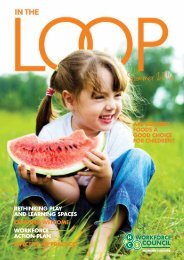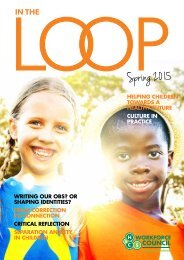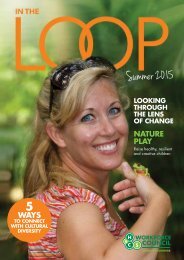Autumn 2015
You also want an ePaper? Increase the reach of your titles
YUMPU automatically turns print PDFs into web optimized ePapers that Google loves.
Are you finding your inbox and post box cluttered with a plethora of professional development<br />
promotional material? With many early education and care services receiving significant funds<br />
through the Long Day Care Professional Development Programme (LDCPDP) there has been a<br />
surge in the professional development options and products being marketed to services.<br />
Here are some simple ideas to help you make sense of<br />
the piles of pamphlets, decide the best way to spend your<br />
professional development budget, and make sure you get the<br />
best possible outcomes for individual staff and for the service<br />
has a whole.<br />
A good start is to check out the Professional Support<br />
Coordinator Alliance Self-assessment Tool - Professional<br />
Learning Plan which provides a step by step process to identify<br />
and plan professional learning needs and a template to record<br />
priorities and action plans.It can be accessed at<br />
www.workforce.org.au or by emailing ECEC@workforce.org.au.<br />
Remember planning for professional learning is an ongoing<br />
cycle and any plan will need to be revisited and adapted<br />
to meet emerging needs or to take advantage of new<br />
opportunities. Don’t feel that you need to create the perfect<br />
planning document before getting started on professional<br />
learning for the year – it is not another form to fill in but a<br />
resource for you to use or adapt.<br />
IDENTIFY PROFESSIONAL LEARNING GOALS<br />
1 Consider your workforce needs<br />
Do you have enough qualified educators to meet regulatory<br />
requirements now and into the future? Have you considered<br />
retention and succession planning for current staff? Supporting<br />
staff to gain qualifications is a wise use of your professional<br />
development budget. If you are in receipt of LDCPD funding<br />
you have a fantastic opportunity to address and proactively<br />
plan ahead to meet your service workforce needs. This level<br />
of funding may never come again, so consider using some<br />
of the money to support educators to gain or upgrade their<br />
qualifications.<br />
2<br />
Gather and assess the information you already have<br />
about the professional learning needs and priorities for<br />
the service.<br />
There is no need to reinvent the wheel. Review and utilise<br />
documentation and planning that the service has already<br />
worked on. This can include:<br />
• Individual staff performance appraisals and professional<br />
development plans,<br />
• The service Quality Improvement Plan (QIP),<br />
• Service Support Plans that have been developed in the<br />
process of accessing Bilingual Support Programs or<br />
Inclusion Support Services,<br />
• The service strategic plan,<br />
• Any relevant notes or minutes from staff or management<br />
meetings.<br />
If some of these processes have stalled or documents are out<br />
of date, now is the time to get them going again. Use ideas<br />
that flow from ongoing cycles of individual performance<br />
reviews and planning and the updating of the service QIP, to<br />
keep professional learning fresh and inspiring for the team.<br />
3<br />
Build on your service strengths and vision<br />
Too often professional learning plans take a deficit approach<br />
focusing only on areas that are identified as a weakness for<br />
individual staff or the service as a whole. Make sure that you<br />
consider the strengths, passions and areas of expertise or<br />
interest of staff, the service, and your extended community<br />
as well. Is there an opportunity for a project that will build<br />
on existing knowledge and create leadership opportunities?<br />
Consider a whole of staff discussion exploring common<br />
interest areas and imagining ways to take service curriculum<br />
and partnerships to new places.<br />
PLANNING PROFESSIONAL LEARNING<br />
OPPORTUNITIES<br />
Along with researching upcoming conferences and learning<br />
opportunities that match service and individual staff learning<br />
goals what else is important as you plan for individual<br />
educators and the whole service?<br />
1 Think outside the square<br />
Like the children we teach, we learn in different ways and most<br />
effectively when we are interested and engaged. Professional<br />
development needs to link to our existing knowledge base<br />
and scaffold our learning and skill development. Sometimes a<br />
workshop environment cannot provide this. As well as paying<br />
for conference and workshop attendance, your professional<br />
development budget can be used to backfill staff so that they<br />
can have time to read, research or visit other services or<br />
organisations. In addition to professional development sessions<br />
and accredited training, the PSC Alliance Self-assessment<br />
Tool - Professional Learning Plan lists the following possible<br />
approaches to meeting learning needs:<br />
• Professional readings<br />
• eLearning and online learning modules<br />
• Team meeting packages<br />
• Customised sessions for whole staff teams<br />
• Professional conversations and networking<br />
• Mentoring and coaching<br />
• Peer observation<br />
• Practitioner inquiry and action research<br />
• Service visits.<br />
WORKFORCE.ORG.AU 5




